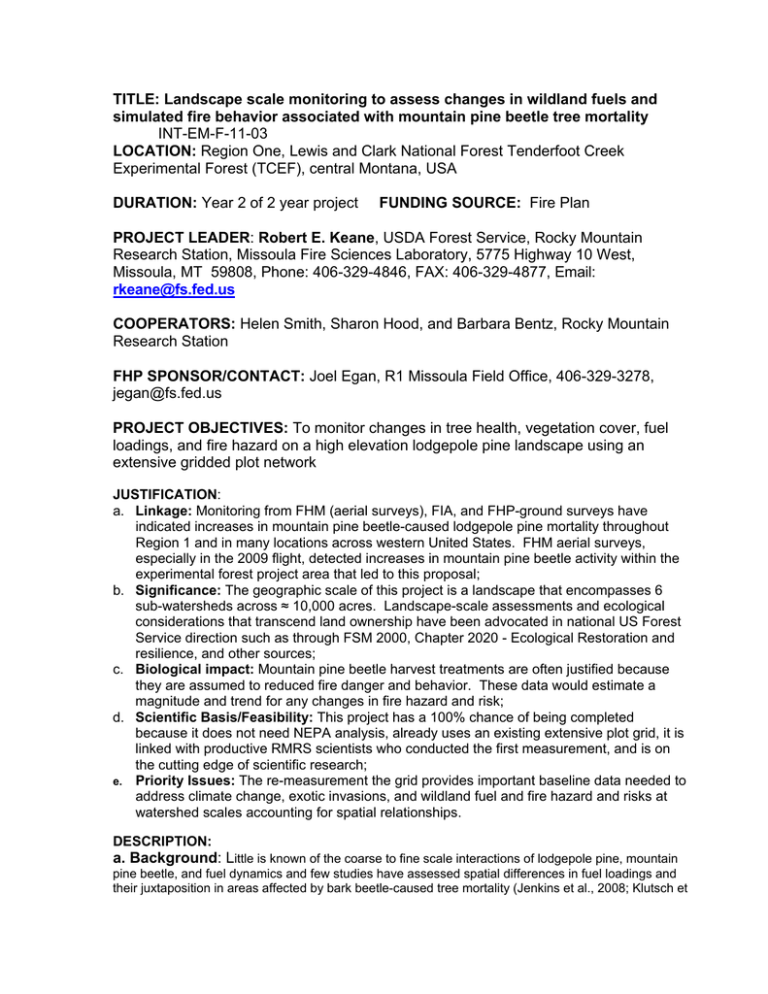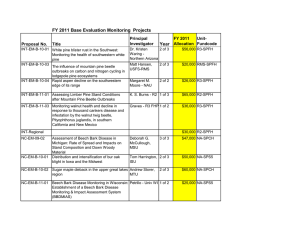INT-EM-F-11-03 Experimental Forest (TCEF), central Montana, USA TITLE:
advertisement

TITLE: Landscape scale monitoring to assess changes in wildland fuels and simulated fire behavior associated with mountain pine beetle tree mortality INT-EM-F-11-03 LOCATION: Region One, Lewis and Clark National Forest Tenderfoot Creek Experimental Forest (TCEF), central Montana, USA DURATION: Year 2 of 2 year project FUNDING SOURCE: Fire Plan PROJECT LEADER: Robert E. Keane, USDA Forest Service, Rocky Mountain Research Station, Missoula Fire Sciences Laboratory, 5775 Highway 10 West, Missoula, MT 59808, Phone: 406-329-4846, FAX: 406-329-4877, Email: rkeane@fs.fed.us COOPERATORS: Helen Smith, Sharon Hood, and Barbara Bentz, Rocky Mountain Research Station FHP SPONSOR/CONTACT: Joel Egan, R1 Missoula Field Office, 406-329-3278, jegan@fs.fed.us PROJECT OBJECTIVES: To monitor changes in tree health, vegetation cover, fuel loadings, and fire hazard on a high elevation lodgepole pine landscape using an extensive gridded plot network JUSTIFICATION: a. Linkage: Monitoring from FHM (aerial surveys), FIA, and FHP-ground surveys have indicated increases in mountain pine beetle-caused lodgepole pine mortality throughout Region 1 and in many locations across western United States. FHM aerial surveys, especially in the 2009 flight, detected increases in mountain pine beetle activity within the experimental forest project area that led to this proposal; b. Significance: The geographic scale of this project is a landscape that encompasses 6 sub-watersheds across ≈ 10,000 acres. Landscape-scale assessments and ecological considerations that transcend land ownership have been advocated in national US Forest Service direction such as through FSM 2000, Chapter 2020 - Ecological Restoration and resilience, and other sources; c. Biological impact: Mountain pine beetle harvest treatments are often justified because they are assumed to reduced fire danger and behavior. These data would estimate a magnitude and trend for any changes in fire hazard and risk; d. Scientific Basis/Feasibility: This project has a 100% chance of being completed because it does not need NEPA analysis, already uses an existing extensive plot grid, it is linked with productive RMRS scientists who conducted the first measurement, and is on the cutting edge of scientific research; e. Priority Issues: The re-measurement the grid provides important baseline data needed to address climate change, exotic invasions, and wildland fuel and fire hazard and risks at watershed scales accounting for spatial relationships. DESCRIPTION: a. Background: Little is known of the coarse to fine scale interactions of lodgepole pine, mountain pine beetle, and fuel dynamics and few studies have assessed spatial differences in fuel loadings and their juxtaposition in areas affected by bark beetle-caused tree mortality (Jenkins et al., 2008; Klutsch et al., 2009). Further research has been advocated to assess interactions between bark beetle and wildland fire disturbance agents (Negron et al., 2009). To-date, no studies have assessed the impact of mountain pine beetle (MPB)-caused lodgepole pine mortality on fuel loadings and wildland fire behavior simulated with geostatistical, physics-based fire modeling for a contiguous, landscape-level analysis. In 1997, RMRS Missoula Fire Sciences Laboratory scientists established a gridded plot network across the entire Tenderfoot Creek Experimental Forest (TCEF) to describe the spatial distribution of surface and canopy fuels at a landscape-scale that covers 6 sub-watersheds and 9,000 acres. Variables measured included fuel loadings, undergrowth plant cover and height including weeds, and tree attributes on 320 tenth acre plots spatially distributed in a square, grid network. Recently, mountain pine beetle-caused mortality has intensified within and surrounding the TCEF project area. Aerial detection surveys in 2009 estimated ≈ 3-10 and 5-20 trees acre-1 in multiple areas within and surrounding TCEF, respectively. Evaluations conducted in 2010 found an average of 1-2 trees per plot dying or dead from MPB indicating the importance of resampling of fuels at this incipient MPB outbreak stage. This increase in bark beetle activity provides a unique opportunity to assess short and long-term impacts of MPB-caused mortality on surface fuel loadings and simulated wildland fire behavior at a landscape spatial scale. Specifically, data obtained from this re-measurement will be compared to fuel loadings and simulated fire behavior from endemic (2001) to incipient-epidemic (as described in Carroll et al., 2006) 2011/2012 beetle levels. Assuming an increase in beetle-caused mortality, Fire Lab Scientists will conduct a subsequent re-measurement in 2016 and 2021 to assess MPB influence on fuels and fire behavior at endemic, incipient-epidemic, and epidemic levels. b. Methods: We will measure trees, fuels, and vascular plant cover and height on a network of 320 tenth acre circular macroplots that were established in 1997-2001 that were monumented with a 4 ft aluminum pole as plot center. On these plots we will use the FIREMON sampling protocols (Lutes et al. 2006). There are three nested plot sizes in this study that all use the stake/rod as plot center or an orientation point. The largest plot is a circular 400 m2 macroplot (tenth acre) within which saplings, trees, and 1000-hr downed woody (logs) fuel will be measured. Under that is a 2.1 m (1/300 acre) radius seedling plot within which all seedlings will be tallied by species and size class. Then eight, 1 m2 microplots established from along the planar transect transects will be used to estimate vascular plant species, cover, and height. Tree population data sampled using the FIREMON Tree Data method will be used to compute crown and canopy fuel characteristics. We will tag and measure all dead and live trees (sapling and mature trees) and record species and health class, and measure the DBH, tree height (m), canopy fuel base height (m), and crown class; species and height class (0-20 cm, 20-40 cm, 40-60, 60-80, 80-100, 100-140) will be measured on all live seedlings (trees less than 4.5 feet tall). We will sample fine downed woody fuels characteristics using the planar intercept method and the Photoload fuel loading method (Keane and Dickenson 2004). We will measure all logs within the 404 m2 macroplot along with the log decay class. We will visually assess vertically projected canopy cover and average height of all vascular plant species including weeds within eight 1m x1m microplots. We will describe spatial and temporal changes in fuel loadings over a spatial domain using spatial statistics and complex GIS and geostatistical analysis. Surface and canopy fuel conditions will be extrapolated across the entire TCEF and we will use mechanistic fire physics programs (FLAMMAP, FSSIM, FARSITE, FIRETEC) to simulate fire behavior and hazard. A detailed study plan is available. c. Products: 1. Field Data Base (April 1, 2012), 2. Peer-reviewed publication summarizing changes in fuel loadings and tree mortality following low levels of beetle activity (Dec 2012), 3. Integration of research findings into technology transfer vehicles of FMI, WFCG coursework, and other studies (Dec 2012), 4. Remeasurement of grid (circa 2016 and 2021). d. Schedule of Activities: July-Sept 2011: Sampled 222 of 320 plots on TCEF grid, Winter 2012: Enter field data and conduct preliminary analyses when funding becomes available, July-Aug 2012: Sample remaining plots, Sept to Dec 2012: Write publications e. Progress/Accomplishments: We sampled 222 of the 320 grid points in the 2011 field season, which was much more than we estimated because of the late allocation of the FHP EM funds which resulted in the hiring of untrained student crews using the STEP authority because all other hiring avenues were unavailable. Moreover, early sampling was also hampered by a cold wet spring and late snow melt. We could not enter any of the collected data because of funding constraints so we are unable to do any data entry or analysis until year two funds are allocated. REFERENCES Jenkins, M. A., E. Hebertson, W. Page, and C. A. Jorgensen. 2008. Bark beetles, fuels, fire and implications for forest management in the Intermountain West. Forest Ecology and Management 254:16-34. Lutes, D. C., R. E. Keane, J. F. Caratti, C. H. Key, N. C. Benson, S. Sutherland, and L. J. Gangi. 2006. FIREMON: Fire effects monitoring and inventory system. General Technical Report RMRSGTR-164-CD, USDA Forest Service Rocky Mountain Research Station, Fort Collins, CO USA. COSTS: As we only sampled 70% of the plots, FY12 funding is requested to finish field sampling for 98 remaining plots. An additional year is requested and the data analysis and publication products for this project are anticipated to be completed by end of FY13. We have identified a need for additional funding and an additional year to complete this project. FY12 EM funding is requested at 43k (slightly above the original 38.4k anticipated in original proposal) to complete remaining field data collection. This will fund a group of six GS-4/5 (~$1,252/PP) technicians working in two crews of three people for 5 PPs (June thru Sept), travel at $31.50/day during the summer of 2012 ($37,000+$5,000 per diem+$1,000 overhead=$43,000). RMRS will provide funding for a supervisor (Helen Smith) to oversee crews and field supplies to outfit crews. Additional 36K of FY13 funding is required to complete the data entry, analysis, and publication portions of this project. Data entry will be completed by two, GS-4 students working for 8 PPs (@$1,200/PP+$1,000 overhead= $20,200). Data analysis will fund GS12 GIS specialist to perform GIS and fire analysis (4PP@ $3,700/PP+$1,000 overhead=$15,800). RMRS Fire Lab will pay for a supervisor (Helen Smith) and a Scientist (Bob Keane) to oversee this project and produce publications. Collaborative funding will be sought from RMRS and other potential sources in 2012 to solicit FY13 funds to complete project. Should no FY13 funds be obtained from any source, program leaders will still complete this project but it will take additional time. Item YEAR FY2012 Administration Total Requested FHM EM Funding OtherSource Funding Source Salary 37,000 45,000 RMRS Overhead Travel Supplies 1,000 5,000 0 43,000 10,000 1,000 5,000 60,000 RMRS RMRS RMRS RMRS A need for FY13 funds has been identified and additional, collaborative funding will be sought to complete data entry and analysis. Collaborative OtherFunding Source Source YEAR FY2013 Sought Funding Administration S 36,000 10,000 RMRS



